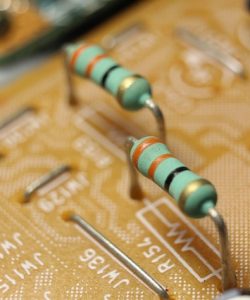Resistor with a value much lower than the original value? Find out what it means.
Resistors are essential components in electronic circuits, responsible for controlling the flow of electric current. However, sometimes we may come across resistors that have a value much lower than expected. This phenomenon is known as a “shorted resistor” and can indicate a defect. In this article, we have explored what a shorted resistor means, its possible causes, and the consequences for the circuit.
What is a shorted resistor?
A shorted resistor occurs when the measured resistance is much lower than the specified nominal value. Instead of resisting the flow of electric current as expected, the resistor allows the current to flow practically unrestricted, resulting in a very low resistance value.

Possible causes of a shorted resistor:
Physical damage: If the resistor has suffered physical damage such as fractures, cracks, or improper contact, it can create a low-resistance path and cause an internal short circuit.
Overloading: When the resistor is exposed to excessively high current that exceeds its heat dissipation capacity, it can overheat and become damaged, resulting in a short circuit.
Material failure: While rare, there can be a failure in the resistor’s own material, such as a coating or resistive element failure, leading to a short circuit.
Consequences and solutions:
When a resistor is shorted, it can cause problems in the circuit, such as excessive current flow, overheating, and, in extreme cases, even damage to other nearby components. To fix this issue, it is generally necessary to replace the faulty resistor with a new one.
It is important to carefully check the circuit and adjacent components to identify the cause of the short circuit before replacing the resistor. This may involve visually inspecting the resistor for visible damage, checking for excessive currents, or investigating possible failures in other components.
A shorted resistor is a problem that can occur in electronic circuits when the measured resistance value is much lower than the nominal value. Physical damage, overloading, material failures, or manufacturing errors can cause this undesired behavior. When detecting a shorted resistor, it is important to replace it properly to ensure the correct functioning of the circuit. Additionally, conducting a thorough analysis of the circuit can help identify and address the underlying causes of the short circuit, preventing future issues. Remember to always replace the resistor with one of the same power rating or higher, never lower, and also respect the specified tolerance range in the service manual.
And when the resistance value is much higher than the original value?
When the resistance value is much higher than the nominal value, it is referred to as an “open resistor.” An open resistor is a term used to describe a defect in which no electric current flows due to an interruption in the resistive element. In other words, an open resistor is a resistor that exhibits an infinitely high resistance, preventing the flow of current through it.
Possible causes of an open resistor can include component failures such as breakage in the resistive element, wear, or physical damage. Loose or broken connections on the resistor’s terminals can also be causes.
When a resistor is open, it interrupts the current flow in the circuit, which can affect the normal operation of the system. The effects can vary depending on the resistor’s function within the circuit. For example, if the resistor is part of a voltage divider network, the circuit can become unbalanced, and the voltage can be affected.
To resolve the issue of an open resistor, it is necessary to replace it with a new functional resistor. It is also important to check the connections and soldering on the resistor’s terminals to ensure there are no additional problems.
In summary, an open resistor is a resistor that exhibits an interruption in the current flow due to a failure in the component or its connections, requiring replacement to restore proper circuit operation.
Tip:
There is no problem if a resistor has a resistance value higher or lower than specified in the service manual, as long as the resistance variation is within the tolerance value. For example, in the case of a common resistor with a value of 100 ohms and a 5% tolerance, there is no problem in replacing it with one that measures 97 ohms or 102 ohms, where the limits would be a minimum of 95 ohms and a maximum of 105 ohms.
Conclusion:
In conclusion, both a shorted resistor and an open resistor are defects that can compromise the operation of an electronic circuit. A shorted resistor allows current to flow without restrictions, while an open resistor completely interrupts the current flow. In both cases, replacing the faulty resistor is necessary to restore proper circuit operation. Identifying these problems and taking appropriate corrective measures is essential to ensure a functional and reliable electronic circuit.
Conheça as pessoas que tornaram este conteúdo possível
Se você gostou do conteúdo, considere fazer uma doação para os colabadores listados logo abaixo, pode ser apenas o valor de um cafezinho:Você também poderá se interessar por:
0 Comments
Leave a Reply


















Por Matheus Lopes